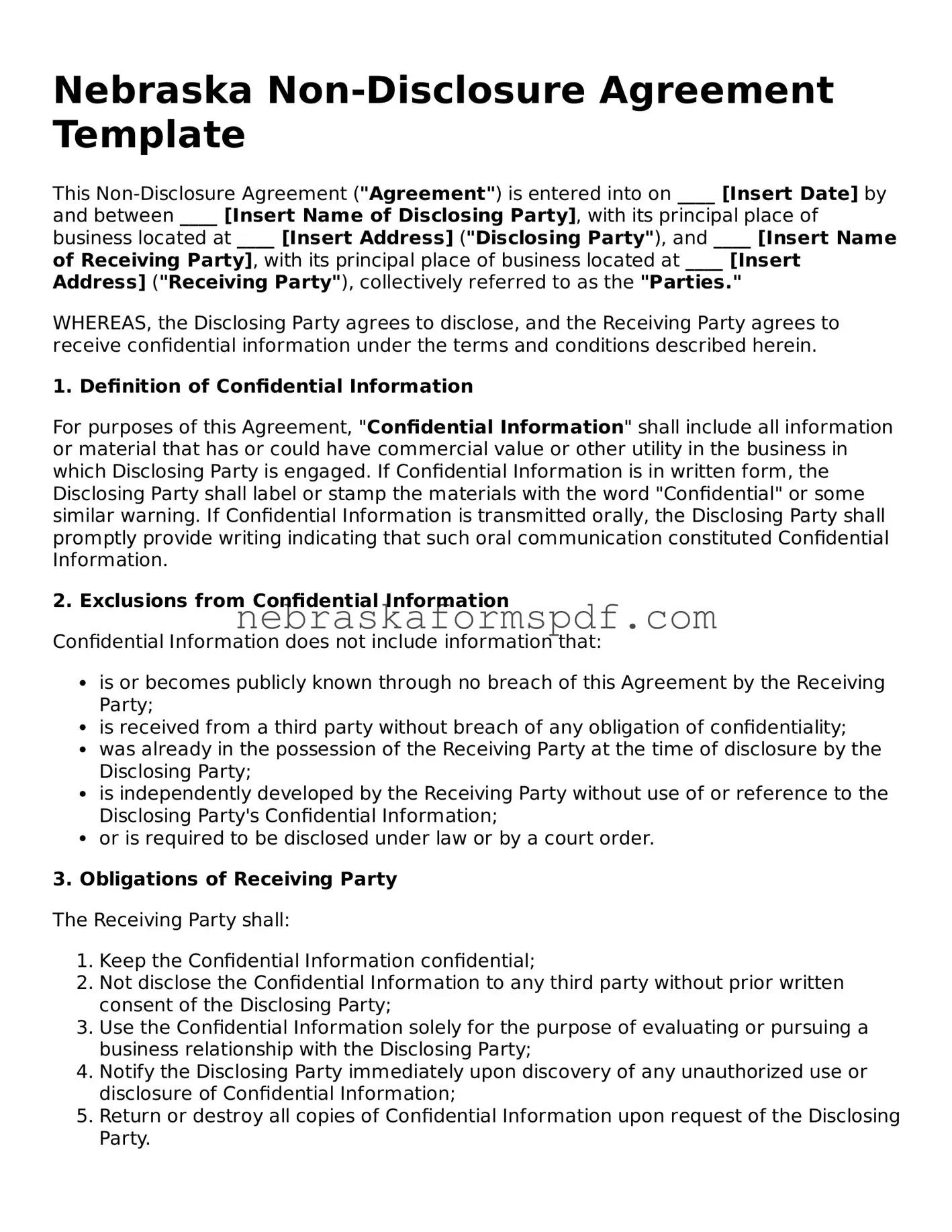Nebraska Non-Disclosure Agreement Template
This Non-Disclosure Agreement ("Agreement") is entered into on ____ [Insert Date] by and between ____ [Insert Name of Disclosing Party], with its principal place of business located at ____ [Insert Address] ("Disclosing Party"), and ____ [Insert Name of Receiving Party], with its principal place of business located at ____ [Insert Address] ("Receiving Party"), collectively referred to as the "Parties."
WHEREAS, the Disclosing Party agrees to disclose, and the Receiving Party agrees to receive confidential information under the terms and conditions described herein.
1. Definition of Confidential Information
For purposes of this Agreement, "Confidential Information" shall include all information or material that has or could have commercial value or other utility in the business in which Disclosing Party is engaged. If Confidential Information is in written form, the Disclosing Party shall label or stamp the materials with the word "Confidential" or some similar warning. If Confidential Information is transmitted orally, the Disclosing Party shall promptly provide writing indicating that such oral communication constituted Confidential Information.
2. Exclusions from Confidential Information
Confidential Information does not include information that:
- is or becomes publicly known through no breach of this Agreement by the Receiving Party;
- is received from a third party without breach of any obligation of confidentiality;
- was already in the possession of the Receiving Party at the time of disclosure by the Disclosing Party;
- is independently developed by the Receiving Party without use of or reference to the Disclosing Party's Confidential Information;
- or is required to be disclosed under law or by a court order.
3. Obligations of Receiving Party
The Receiving Party shall:
- Keep the Confidential Information confidential;
- Not disclose the Confidential Information to any third party without prior written consent of the Disclosing Party;
- Use the Confidential Information solely for the purpose of evaluating or pursuing a business relationship with the Disclosing Party;
- Notify the Disclosing Party immediately upon discovery of any unauthorized use or disclosure of Confidential Information;
- Return or destroy all copies of Confidential Information upon request of the Disclosing Party.
4. Term
This Agreement shall commence on the Effective Date and will continue in effect until ____ [Insert End Date], unless earlier terminated by either Party in accordance with the provisions of this Agreement.
5. Jurisdiction
This Agreement shall be governed by and construed in accordance with the laws of the State of Nebraska, without regard to its conflict of laws principles. Any legal action or proceeding arising under this Agreement shall be brought exclusively in the courts located in the State of Nebraska, and the parties hereby consent to the personal jurisdiction and venue thereof.
6. Miscellaneous
This Agreement constitutes the entire agreement between the Parties concerning the subject matter hereof and supersedes all prior agreements and understandings, whether written or oral, relating to that subject matter. Any amendment to this Agreement must be in writing and signed by both Parties.
IN WITNESS WHEREOF, the Parties have executed this Agreement as of the Effective Date first above written.
Disclosing Party: ___________________________________________________________________
Receiving Party: ___________________________________________________________________
